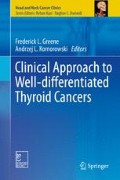Abstract
This chapter discusses the basic diagnostic procedures that should be performed before a decision is taken to operate on a cancer of the thyroid.
Access this chapter
Tax calculation will be finalised at checkout
Purchases are for personal use only
Suggested Reading
Belfiore A, La Rosa GL, Padova G, et al. The frequency of cold thyroid nodules and thyroid malignancies in patients from an iodine-deficient area. Cancer 1987;60:3096–102.
Bonavita JA, Mayo J, Babb J, et al. Pattern recognition of benign nodules at ultrasound of the thyroid: Which nodules can be left alone? AJR Am J Roentgenol 2009;193:207–13.
Cheung K, Roman SA, Wang TS, et al. Calcitonin measurement in the evaluation of thyroid nodules in the United States: A cost-effectiveness and decision analysis. J Clin Endocrinol Metab 2008;93:2173–80.
Costante G, Meringolo D, Durante C, et al. Predictive value of serum calcitonin levels for preoperative diagnosis of medullary thyroid carcinoma in a cohort of 5817 consecutive patients with thyroid nodules. J Clin Endocrinol Metab 2007;92:450–5.
Cooper DS, Doherty GM, Haugen BR, et al. Revised American Thyroid Association management guidelines for patients with thyroid nodules and differentiated thyroid cancer. Thyroid 2009;19:1167–214.
Eloy JA, Brett EM, Fatterpekar GM, et al. The significance and management of incidental [18 F]fluorodeoxyglucose-positron-emission tomography uptake in the thyroid gland in patients with cancer. AJNR Am J Neuroradiol 2009;30:1431–4.
Frates MC, Benson CB, Doubilet PM, et al. Prevalence and distribution of carcinoma in patients with solitary and multiple thyroid nodules on sonography. J Clin Endocrinol Metab 2006;91:3411–17.
Pacini F, Pinchera A, Giani C, et al. Serum thyroglobulin in thyroid carcinoma and other thyroid disorders. J Endocrinol Invest 1980;3:283–92.
Pacini F, Schlumberger M, Dralle H, et al. European consensus for the management of patients with differentiated thyroid carcinoma of the follicular epithelium. Eur J Endocrinol 2006;154:787–803.
Rago T, Santini F, Scutari M, et al. Elastography: New developments in ultrasound for predicting malignancy in thyroid nodules. J Clin Endocrinol Metab 2007;92:2917–22.
Ron E, Lubin JH, Shore RE, et al. Thyroid cancer after exposure to external radiation: A pooled analysis of seven studies. Radiat Res 1995;141:259–77.
Shie P, Cardarelli R, Sprawls K, et al. Systematic review: Prevalence of malignant incidental thyroid nodules identified on fluorine-18 fluorodeoxyglucose positron emission tomography. Nucl Med Commun 2009;30:742–8.
Sippel RS, Caron NR, Clark OH. An evidence-based approach to familial nonmedullary thyroid cancer: Screening, clinical management, and follow-up. World J Surg 2007;31:924–33.
Author information
Authors and Affiliations
Corresponding author
Editor information
Editors and Affiliations
Commentary
Commentary
The vast majority of non-palpable and even palpable small nodules are histologically benign and the potential for malignancy is low. Although a growing incidence of DTC has been reported worldwide, the detection of a malignant nodule still resembles ‘finding a needle in a haystack’ in many cases. The choice of diagnostic procedures is dependent on local circumstances and iodine supply, and the prevalence of goitre. Technetium-based thyroid scanning plays an important role, especially in areas of iodine deficiency, as autonomously functioning nodules rule out malignancy. Sodium-iodine-symporter expression in DTC is supposed to be 1000-fold lower than in benign thyroid tissue. At least in the hands of our team, only hypofunctioning nodules merit FNA on account of the high rate of false-positive results (‘follicular neoplasia’) in ‘hot nodules’. Borget et al. showed that the cost of FNA depends on cytopathologist performance and unsatisfactory specimen rate. The authors foresee that in the future, routine ultrasound guidance and on-site assessment of cytopathological adequacy would help reduce costs.
The ultimate initial test for thyroid examinations remains neck ultrasound because of its easy accessibility and effectiveness; the main drawback is investigator dependency. The use of high-resolution ultrasonography is generally considered the first choice for the evaluation of thyroid size and morphology. It is much more reliable than palpation of the gland (which has an accuracy of only ~40 %) and reduces the interobserver variation. Sonographic features as predictors of malignancy have been widely reported and debated; the presence of multiple criteria increases specificity at the cost of sensitivity.
The number of incidental findings, i.e. ‘hot spots’ in the thyroid region, has increased with the advent of PET/CT. A systematic use of FDG-PET scanning for screening reasons cannot be recommended because of the lack of specificity, especially in areas with a high prevalence of goitre.
Rights and permissions
Copyright information
© 2012 The Author(s)
About this chapter
Cite this chapter
Jarząb, B., Handkiewicz-Junak, D. (2012). Preoperative Endocrine Management of Differentiated Thyroid Cancer. In: Greene, F., Komorowski, A. (eds) Clinical Approach to Well-differentiated Thyroid Cancers. Head and Neck Cancer Clinics. Springer, New Delhi. https://doi.org/10.1007/978-81-322-2568-3_6
Download citation
DOI: https://doi.org/10.1007/978-81-322-2568-3_6
Publisher Name: Springer, New Delhi
Print ISBN: 978-81-322-2567-6
Online ISBN: 978-81-322-2568-3
eBook Packages: MedicineMedicine (R0)

